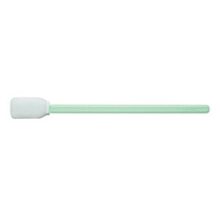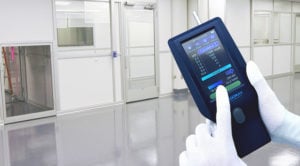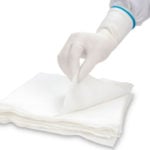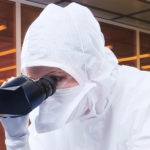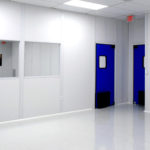Table of Contents
Cleanroom Wipe Selection and Standards
The ideal cleanroom wipe must meet industrial and regulatory standards concerning chemical, physical, and biological compatibility. Wipe fabrics undergo a strict examination to simulate manufacturing outcomes in the real world.
Stretch and strength, chemical compatibility, task efficiency, sorbency, shed, retention, and biological harmony have unique consequences in both high-tech cleanrooms and general manufacturing floors.
Whether at the corner pharmacy or a NASA facility, a wipe is required at almost every intersection of aqueous substances, adhesives, solvents, cleaning, and impurity removal.
Cleanroom Wipe Evaluation Quick Links
Read: Cleanroom Wipe Testing Standards for ISO, IEST, and ASTM Organizations
Types of Cleanroom Wipe Contamination
- Physical contamination: Fibers, particles, process materials
- Chemical contamination: vapor, gasses, moisture, molecules
- Biological contamination: fungi, bacteria, viruses, and their counterparts:
- Pyrogens
- Endotoxins
- Mycotoxins
Cleanroom Fiber Contamination
Fibers exist both as large strands and micro-particulates from small tears, abrasion, shedding, or linting.
For example, the wipe down of catheters or guidewires may introduce fibers to the patient, either directly from residual fibers on the device or when resettling from the air.
“A 5-year retrospective study was done on all available postmortem cases to systematically assess the prevalence of particulate embolization in patients with arteriovenous malformations. Particulate embolization, primarily due to cotton fiber, was present in 25% of the cases.”
Because ISO standards dictate particulate for every square meter of an ISO cleanroom, most facilities understand strategies for eliminating a problematic size and character of particulate.
Read: ISO Cleanroom Wipe Application – Compliance for Wipers
Wipe Characteristics by ISO Class & Materials
| Example Application | Cleanroom Classification | Suggested Materials | Suggested Edge |
| Semiconductor, Isolator | Class 10 / ISO Class 4 | Polyester Knits | Sealed Edge |
| Semiconductor, Aseptic Filling Area | Class 100 / ISO Class 5 | Synthetic Knits | Sealed Edge |
| Pharmaceutical Prep Area | Class 1,000 / ISO Class 6 | Polycellulose Blends | Cut Edge |
| Medical Device Manufacturing | Class 10,000 / ISO Class 7 | Cotton, Foam, or Composites | Cut Edge |
Testing Cleanroom Particle Fiber Counts
Particle counters allow real-time sampling of microscopic particles in either aerosol or liquid forms. A particle is measured by a “channel” within the particle counter. Each channel is responsible for measuring a specific size of the particle.
Particle Counter Channel Sizes
Particles between 30 to 60 µm usually consist of organic and nonorganic dirt, fibers, and the larger pollens and mold spores. Particle counters for cleanroom configurations measure much smaller particles, usually between 0.2 µm – 2.0 µm.
Most particle counters range between 4 – 6 channels that calculate the number of particles in a given volume of air. (0.2 µm, 0.3µm, 0.5 µm, 1.0 µm, 1.5 µm, & 2.0 µm.
Read: Particulate and Fiber Counting Tests | Procedures
Cleanroom Wipe Consistency and Manufacturing Technology
Consistency is an important part of repeatable cleanroom wipe analysis and results which have led some wipe manufacturers toward fully automated, hands-free cleanroom wipe production processes. Virtually every cleanroom product is lot coded for tracking and traceability.
Vertex Wipe Manufacturing Process
Vertex® non-sterile dry cleanroom wipers are made from 100% polyester material with a sealed edge processed on Texwipe’s fully automated Vertex® manufacturing system. Vertex® process advances cleanroom wiper manufacturing technology, bringing it to the highest level in the industry.
Texwipe Polyester Knit Wipes
Vertex® non-sterile dry cleanroom wipers are made from 100% polyester material with a sealed edge processed on Texwipe’s fully automated Vertex® manufacturing system. Vertex® process advances cleanroom wiper manufacturing technology, bringing it to the highest level in the industry.
Vertex® dry wipers are designed for high sorption capacity which reduces the number of wipes needed for spill control. The sealed edge minimizes particle release from the wiper edges.
Meets USP <797> and USP <800> requirements and is autoclave safe
- Recommended for ISO 4-7 controlled environments.
- Tested for cytotoxicity and bacterial endotoxins
- Low ions, NVRs (nonvolatile residues), particles/fibers
- Designed for high sorption capacity
Related Documentation
- AAMI TIR17:2008 Compatibility Of Materials Subject To Sterilization
- For medical devices, ISO 10993 covers the biological evaluation of medical devices for toxicity.
- ISO 14698-1 and ISO 14698-3 – Suitable procedures for cleaning and disinfection
- ISO 9073-10:2005-03 Textiles – Test Methods for Nonwovens – Part 10
Guideline for Disinfection and Sterilization in Healthcare Facilities, 2008/163
Electronics – How Trace Metals & Heavy Metal Contamination Diminish Production Gains
Trace metal contamination ads extra concern in semiconductor facilities. Metallic content may bridge extremely small circuit connections with unpredictable behavior and may incur device failure in early or late stages.
“Metals and particles, present at high-temperatures may spread and diffused into the semiconductor interior causing thermal oxidation, diffusion, and epitaxial growth. Epitaxial growth is a type of crystalline growth on a substrate material. Epitaxial structures have many applications for microelectronics, optoelectronics, and photonics.”
- Designed for use in ISO Class 3 and higher cleanroom environments
- Designed for the highest level of contamination control in critical processing applications
- Oxidation, Metallization, CVD or Photolithography processes
- Chamber cleaning and CMP processing
- Stencil and other print roll cleaning applications
- Steam autoclavable for aseptic applications
- Cleaning of medical device products
- Applying and removing cleaning and disinfecting solutions
Ionic Contamination
Cleanroom wipes with ionic content may cause unacceptable damage in high-performance cleanroom environments. Na, Li, NH4, K, Mg, Ca, F, Cl, NO4, PO4, and SO4 are common ions in textile fabrics. Failure occurs when Ions cause corrosion or short-circuiting on wafer components. One mitigative solution for cleanroom wipes with ionic content is deionized water. Deionized water attracts ionic content which is then removed by filtering or removed.
- Releasable particles
- Releasable ions PPM (Li, Na, Mg, Al, K, Ca, Fe, F, Cl, Br, NH4, NO4, PO4, and SO4)
- NVR (Non-Volatile Residue)
- Heavy metals
- Electrostatic properties
“Ions are the quantified species of matter that can be extracted from a wiper and are generally expressed as ppm or ppb. While the extraction method could use elevated temperature, most, if not all, wiper manufacturers use an ambient temperature soak for extraction.”
Particle Release from Wipers and Other Materials Under Conditions of Moderate Mechanical Stress
Nonvolatile Residue – NVR – in Cleanrooms
There are a number of processes that reduce NVR levels for end-user products including solvent extractions, laundering, and hyper-clean manufacturing processes.
What is NVR?
“Most if not all cleanroom wipes contain a variety of NVR contaminants. These include surfactants, sizing compounds, waxes, oils, adhesives, electrostatic agents, and greases.”
Cellulose and paper-based wipes have naturally low extractable organic residues. Less ideal is the tendency for paper, cotton, and cellulose to shed trace fibers and particulates.
Cotton contains moderate amounts of NVR residue and is best suited for absorption followed by cellulose and then microfiber.
Polyesters contain the next lowest amounts of particle deposits.
Synthetics such as nylons, polyamides, polyurethanes, and polypropylene contain the most significant amounts of NRV which usually dissolves when interacting with organic solvents such as alcohols, aldehydes, and ethers.
Foam materials continue to show promise for clean outcomes where fabric-free materials are ideal. Studies show growing demand where fabric or gauze products interfere with the wipedown of stents.
-
Texwipe’s Low TOC Alpha® Swab Series is made from the cleanest 100% polyester knit materials.
-
Precision-manufactured, every swab is constructed to exacting and consistent tolerances without the use of adhesives for superior performance.
-
Cleaned using a proprietary process to make this Series suitable for use in Total Organic Carbon (TOC) analysis as part of a cleaning validation protocol.
Novel Geometries for Medical Device Wipes
Cleanroom wipe manufacturers have also regeared many fabrics into novel blends, composites, and geometries that better adapt for a specific surface, solvent use, or device application.
The TX8723 is a wipe designed specifically for the small footprint of a medical device such as guidewires. Because the hand is taller than it is wide, the 6 X 9 surface area fits more closely with the palm for tactile response and less material waste.
For more on wiper edge construction, fabric weights, and materials types: Guide to cleanroom wiper fabrics, materials, substrates, and characteristics.
Foam Medical Device Wipes
Foam cleanroom wipes are an emerging trend for certain tasks such as medical device wipedown and aseptic processing. Novel foam composites allow sorbency, uniform solvent deposit, and favorable ESD during wipedown disinfection.
ISO Class 5 – 7
- 100% fiber free
- Static dissipative to minimize the risk of ESD events.
- Pyrogen-free for Medical Device wipe-down.
- Will not interfere with curing of silicones or adhesives
- Excellent abrasion resistance to reduce particle generation
Cleaner Task Wipes Improve Manufacturing Outcomes
Wipe testing and validation helps manufacturers select the proper process materials and thus improve company performance when polishing sensitive options, mixing sterile drugs, or analyzing conductive failures such as dendritic growth and ECM in electronics devices.
Even small inconsistencies during high-volume manufacturing can turn best-sellers into market failures. The true costs of poor manufacturing controls are often not realized until products have already left the factory and reached end-users.
Long-lasting, high integrity devices fetch higher prices at the market, especially for electronics manufacturers and assemblers. Most device failures, especially circuit mounted devices, are traceable back to a specific part of the assembly or manufacturing process. Returns, sales forfeitures, warranty claims, customer displeasure, and brand erosion swell when quality doesn’t meet expectations.
FAQ
Physical, Chemical, Biological, Sound, Vibration, Electrical
Biological contamination is a frequent precursor to human illness or discomfort (pg. 322) including infection, intoxication, and immunologic responses.
For Medical Devices, Pharmaceuticals, and Healthcare sectors, biological contamination is a high risk for patients, especially those undergoing surgery recovery, the young and old, or those undergoing immunotherapies for cancer and autoimmune disorders.
Fibers, particulates, spores, pyrogens, residues, and Gram-negative bacteria.
Production Automation Corporation (PAC) is a factory-direct cleanroom supplier for environments, supplies, apparel, and furniture.
Every PAC product is backed by dedicated customer service, sales support, and in-house specialists.
Need help with a technical manufacturing solution? We’re the specialists in your back pocket.
Shop the PAC website or our CleanRoomProducts.com specialty division for factory-backed products curated by factory-trained specialists.
- We diligently choose suppliers and sell only direct authorized products
- We 100% stand behind all of our products
- Enjoy great pricing and great customer service
- Select from thousands of items on our site
- Customize your selection with accessories
- Get the best possible pricing available from any cleanroom specialty supplier
- Our product specialists have factory training on the items we sell
The content provided is for informational purposes only. It does not constitute a recommendation for your facility or organization. This post serves as a general guideline and summary. All information is subject to change and requires temporal review on a case-by-case basis according to state and federal law. The content herein, linked content or other web content provided by Production Automation Corporation (PAC) makes no claims as to the final interpretations or implementation of regulatory documents provided by the FDA, State Board of Pharmacy, or the United States Pharmacopoeia (USP). PAC provides on-staff environmental control specialists available every business day, toll-free (888) 903-0333 for consultation at no cost, no obligation.
Manufacturing Related
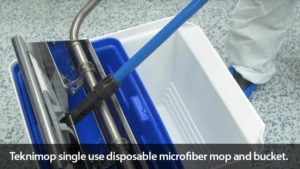
What’s the Correct Way to Wipedown a Surface? What’s the Advantage of Microfiber Wipes?
What is the proper technique for wipedown and sanitation of surfaces? Why is a microfiber wipe most effective for viruses and infection control?

How Do I Properly Wipe Down Surfaces in Cleanrooms and Labs?
What are the proper steps for wiping surfaces, biological isolators, and laminar flow cabinets, and excess hazardous drugs?

Cleanroom Wipes for Pharmaceuticals: Pyrogen Testing Methods
Cleanroom wipes and gloves undergo LAL and Agar Overlay Analysis when testing for pyrogen and endotoxin levels. This post details the methodology, historical relevance, and explores cleanroom solutions for pyrogen-free and low-endotoxin gloves and garments.
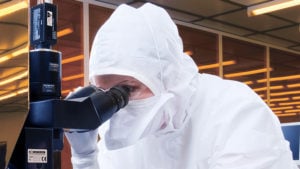
Particulate and Molecular Contamination Tests for Cleanroom Wipes and Fibers
The majority of wiper contamination tests probe for particles, fibers, ions, nonvolatile residue, and bio-contaminants. Cleanroom wipe test methods detail and measure the extraction and enumeration particles, fibers, and other contamination released from wipers (or other materials), usually in a wetted state, under conditions of moderate mechanical stress.
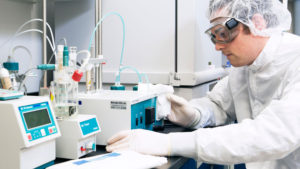
Cleanroom Wipe Testing Standards for ASTM, IEST & ISO Organizations
ISO cleanroom wipe classification is important, but is it enough? A clean room wipe selection criteria should meet baseline particulate shed thresholds for the end-user environment. Like any cleanroom rated product, cleanroom wipe manufacturers qualify ISO wipers between ISO Class 1 – ISO Class 9 as specified in step with cleanroom classifications of the International Standards Organization (ISO). The majority of cleanroom classifications fall between ISO 5 – ISO 8.
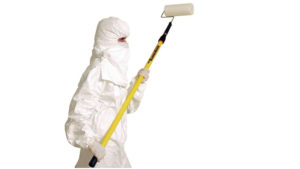
Cleanroom Sticky Rollers and Foam Mops for Walls Ceilings, and Floors
Cleanroom tacky rollers and sticky foam rollers remove particulate from flat and slightly textured surfaces within a cleanroom. Extendable mop handles with adhesive rollers on the ends allow easy access to cleanroom, floors, ceilings, and walls.

Polycellulose & Polyester Cleanroom Wipe Supplies
Here’s the guide to buying cleanroom wipes that stay on-budget. Differing package sizes, bulk counts, edge types, material options, cloth size, weights, ISO class, substrates, ionic levels…comparing cleanroom wipes is mind numbing. 50% of leading cleanroom wipe advertisers don’t even offer prices online!
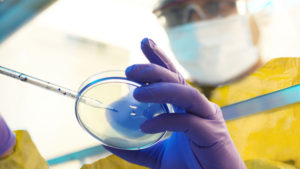
Kimberly-Clark Professional™ PPE, Garments, and Recycling Program (RightCycle)
Demand for eco-sensitive products and zero-waste initiatives has never been more pronounced. When you purchase Kimtech and KleenGuard products from Production Automation (PAC), you get the benefit of RightCycle by Kimberly-Clark Professional. This program delivers a sustainable approach for managing used nitrile gloves, single-use apparel items, and safety eyewear.
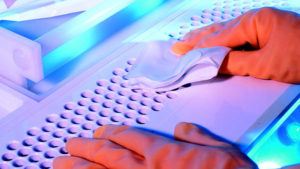
New: Texwipe Cleanroom Products
Texwipe offers a variety of dry, pre-saturated, and sterile wipes to meet the strict demands of controlled environments. Texwipe swabs are manufactured to exacting and consistent tolerances with lot coded for traceability and quality control.
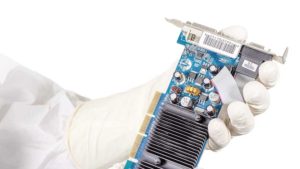
Proper Material for ESD Cleanroom Gloves
ESD cleanroom glove materials have reduced NVR (non-volatile residues) levels for better electrical conductivity. Meanwhile, dedicated ESD fabrics are often not viable for cleanroom use, as they tend to shed particulates at a much higher rate than latex, nitrile, or vinyl gloves.
Related Posts
-
Cleanroom Wipes for Pharmaceuticals: Pyrogen Testing Methods
Cleanroom wipes and gloves undergo LAL and Agar Overlay Analysis when testing for pyrogen and endotoxin levels. This post details the methodology, historical relevance, and explores cleanroom solutions for pyrogen-free and low-endotoxin gloves and garments.
-
Particulate and Molecular Contamination Tests for Cleanroom Wipes and Fibers
The majority of wiper contamination tests probe for particles, fibers, ions, nonvolatile residue, and bio-contaminants. Cleanroom wipe test methods detail and measure the extraction and enumeration particles, fibers, and other contamination released from wipers (or…
-
Medical Device Cleanroom Build Part 7: Cleanroom Validation Steps | Processes
What are the steps for medical device cleanroom validation? Cleanroom validation ensures cleanroom construction meets the performance standards set forth during cleanroom planning, cleanroom installation, and cleanroom calibration.
-
Medical Device Cleanroom Classification
What Kind of Cleanroom Do I Need for a Class II Medical Device? What About Class III? This post classifies medical device cleanrooms for manufacturing and packaging.

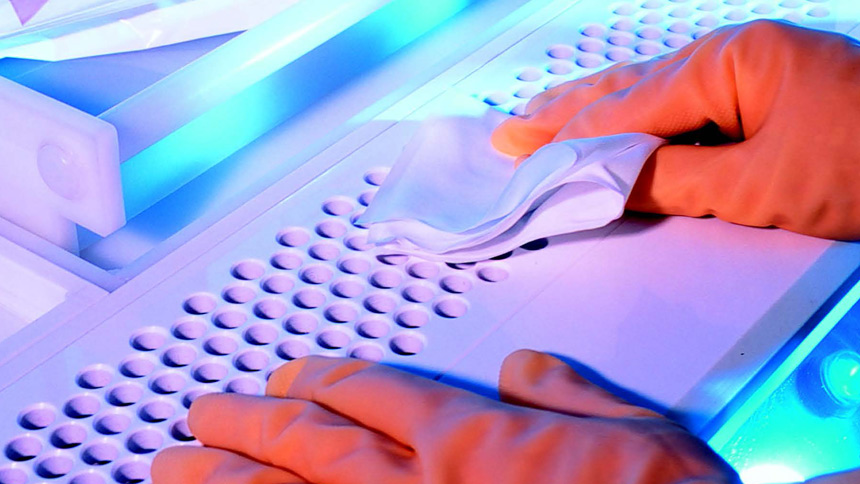

![cleanroom-wipes-capsure-gotopac-300×300[1] berkshire micro seal vp wipes](https://blog.gotopac.com/wp-content/uploads/elementor/thumbs/cleanroom-wipes-capsure-gotopac-300x3001-q8yv1ty9j3wztmvgsl9gjwpyz0q9fkx5mil86kks60.jpg)
